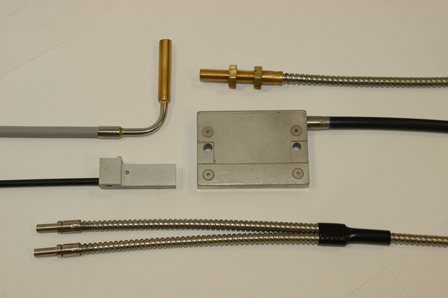Photo Electric Control Cables

TI's headlamFTI manufactures glass and plastic photoelectric light guides as an aftermarket service or OEM supplier.p system is supplied in rigid (for optimal adjustment) or semi rigid (for optimal comfort) styles.
photoelectric-Lightguide
For some types of sensing applications, fiber optic components are used to transmit and receive a light signal, carrying the signal back to a photo sensor, which in turn, actuates an electric control. The overall process senses and reacts to a difference in light intensity to confirm the absence/presence/position of an object.
Fiber optic components protect photoelectric sensors (from heat and harsh environments) and facilitates their use in space-restrictive areas. They may also be used to isolate vibration, keeping the sensor stable in continuous motion applications.
Because fiber optic components can be shaped to match the profile of the object being sensed, they help improve the accuracy of photoelectric control.
Application potential is extensive, sometimes requiring special treatment of the fiber for high temperature, high vacuum and wet/corrosive environments.
Fiber optic cables may be made from plastic or glass fibers. Glass cables can transmit infrared wavelengths, and will withstand more abuse. Plastic has better resistance to fatigue in constant motion applications, and may be less expensive to produce.
COMPONENT DESIGN
The length of most standard fiber optic components is 36”; although special applications can be developed which call for custom lengths. The standard configurations for all fiber optic photoelectric light guides are single (for opposed applications) or dual (bifurcated) for reflective applications.
The common end (bottom leg of a "Y") of a bifurcated light guide is the leg pointed at the object being sensed, and is called the distal end. Distal end configurations for single and bifurcated light guides are typically threaded to aid in mounting the end to an alignment fixture. Because fiber optic cables are typically used in space constrained areas, a broad range of distal end configurations are offered. Straight, 45 degree, and 90 degree bends in the distal end are standard.
The active fiber diameter of most light guides is .125 with .062 and.156 offered as options. The fiber configuration is typically round. Slit (rectangle) shapes are also specified.
Lenses are sometimes provided to help collect light, which extends the effective range of the sensing component.
PVC covered monocoil, and SS interlock sheathing are standard sheathing types.
Because the fiber optic component is mated to different sensor designs, a selection of proximal end (the leg(s) attaching to the sensor are known as proximal end(s)) tips are available,
FTI manufactures components for after-market replacement or initial installation of all major sensor manufacturers, including Omron, SunX, Tritronic, Allen Bradley, Cutler Hammer, ABB, and others.